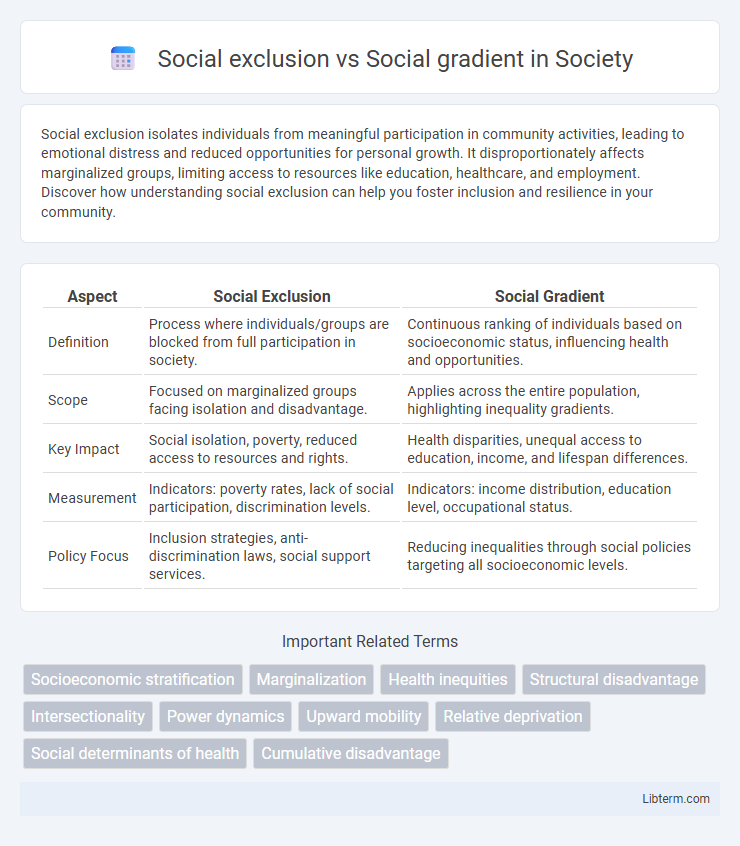Social exclusion isolates individuals from meaningful participation in community activities, leading to emotional distress and reduced opportunities for personal growth. It disproportionately affects marginalized groups, limiting access to resources like education, healthcare, and employment. Discover how understanding social exclusion can help you foster inclusion and resilience in your community.
Table of Comparison
| Aspect | Social Exclusion | Social Gradient |
|---|---|---|
| Definition | Process where individuals/groups are blocked from full participation in society. | Continuous ranking of individuals based on socioeconomic status, influencing health and opportunities. |
| Scope | Focused on marginalized groups facing isolation and disadvantage. | Applies across the entire population, highlighting inequality gradients. |
| Key Impact | Social isolation, poverty, reduced access to resources and rights. | Health disparities, unequal access to education, income, and lifespan differences. |
| Measurement | Indicators: poverty rates, lack of social participation, discrimination levels. | Indicators: income distribution, education level, occupational status. |
| Policy Focus | Inclusion strategies, anti-discrimination laws, social support services. | Reducing inequalities through social policies targeting all socioeconomic levels. |
Understanding Social Exclusion
Social exclusion refers to the process through which individuals or groups are systematically disadvantaged and marginalized from full participation in social, economic, and political life. It involves the denial of access to resources, rights, and opportunities affecting education, employment, healthcare, and social networks. Understanding social exclusion requires examining structural barriers and discrimination that reinforce inequality and limit social mobility.
Defining the Social Gradient
The social gradient refers to the continuous relationship between socioeconomic status and health, where individuals lower on the gradient experience worse health outcomes compared to those higher up. It reflects how social determinants such as income, education, and occupation systematically influence health across the entire population, not just the most disadvantaged groups. This concept highlights that health inequalities are graded and pervasive, rather than solely a result of social exclusion or poverty.
Key Differences Between Social Exclusion and Social Gradient
Social exclusion refers to the process by which individuals or groups are systematically blocked from rights, opportunities, and resources, often leading to marginalization and social isolation. In contrast, the social gradient describes the stepwise or linear relationship between socioeconomic status and health, where people lower on the gradient experience progressively worse health outcomes. Key differences lie in social exclusion being a discrete experience affecting specific populations, while the social gradient is a continuous spectrum highlighting health inequalities across all social strata.
Causes of Social Exclusion
Social exclusion arises from systemic inequalities such as poverty, discrimination, and lack of access to education, healthcare, and employment opportunities, which marginalize individuals and communities. These factors create barriers that prevent full participation in social, economic, and political life, reinforcing isolation and disadvantage. Unlike social gradient, which reflects the continuum of health or well-being across socioeconomic status, social exclusion specifically targets the root causes of marginalization and social segregation.
Determinants of the Social Gradient in Health
The social gradient in health reflects disparities in health outcomes correlated with socioeconomic status, influenced by determinants like income, education, employment, and living conditions. Social exclusion contributes to this gradient by limiting access to healthcare, social networks, and resources essential for maintaining health and well-being. Addressing these determinants requires targeted policies that reduce inequality and promote social inclusion to improve population health across all social strata.
Impact of Social Exclusion on Well-being
Social exclusion significantly undermines well-being by restricting access to essential resources like healthcare, education, and employment, leading to increased stress, poor mental health, and reduced life satisfaction. Unlike the social gradient, which reflects a continuum of health outcomes aligned with socioeconomic status, social exclusion isolates individuals or groups, exacerbating disparities and fostering chronic disadvantage. Studies show that excluded populations experience higher morbidity rates and lower psychological resilience compared to those merely positioned lower on the social gradient.
How the Social Gradient Shapes Societal Outcomes
The social gradient illustrates how health and socioeconomic outcomes progressively worsen with decreasing social status, influencing education, income, and access to healthcare across populations. This continuous gradient impacts societal outcomes by reinforcing disparities in life expectancy, chronic disease prevalence, and employment opportunities. Addressing the social gradient requires policies targeting structural inequalities to promote equitable health and social well-being.
Interplay Between Social Exclusion and Social Gradient
Social exclusion and social gradient interact by reinforcing health disparities, where marginalized groups face limited access to resources, increasing their vulnerability along socioeconomic scales. This interplay manifests as cumulative disadvantages, where social exclusion intensifies the negative effects of lower social gradient positions on physical and mental well-being. Addressing this dynamic requires policies targeting both structural inequalities and social isolation to reduce health inequities across populations.
Policy Responses to Mitigate Social Exclusion
Effective policy responses to mitigate social exclusion prioritize inclusive social welfare programs, affordable housing initiatives, and equitable access to education and healthcare services. Targeted interventions such as community development projects and employment support schemes enhance social integration by addressing systemic barriers faced by marginalized groups. Monitoring and evaluating these policies through social equity indicators ensures adaptation and effectiveness in reducing disparities linked to social gradients.
Strategies for Addressing Social Gradient Inequalities
Strategies for addressing social gradient inequalities emphasize improving access to education, healthcare, and employment opportunities across all socioeconomic levels. Policies focused on redistributive taxation, living wages, and inclusive social protection systems reduce health disparities linked to economic status. Community empowerment and targeted support programs help mitigate the steepness of the social gradient, promoting equity in health and well-being outcomes.
Social exclusion Infographic

 libterm.com
libterm.com